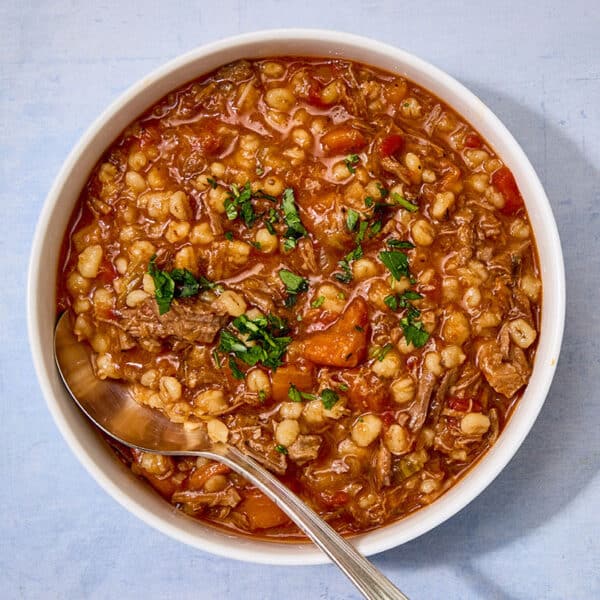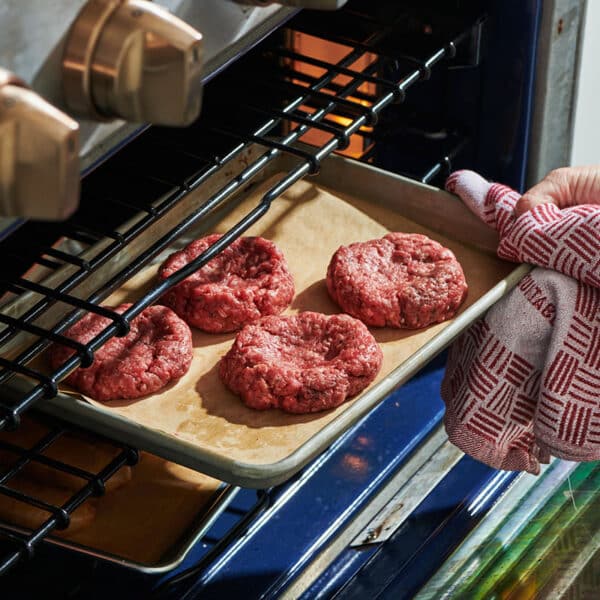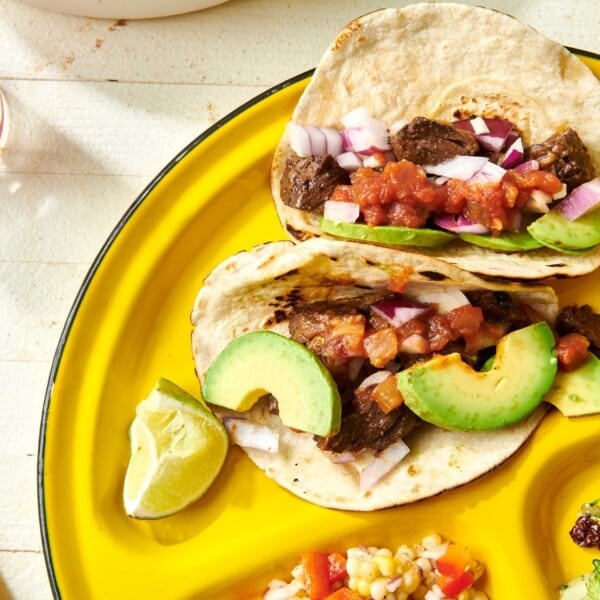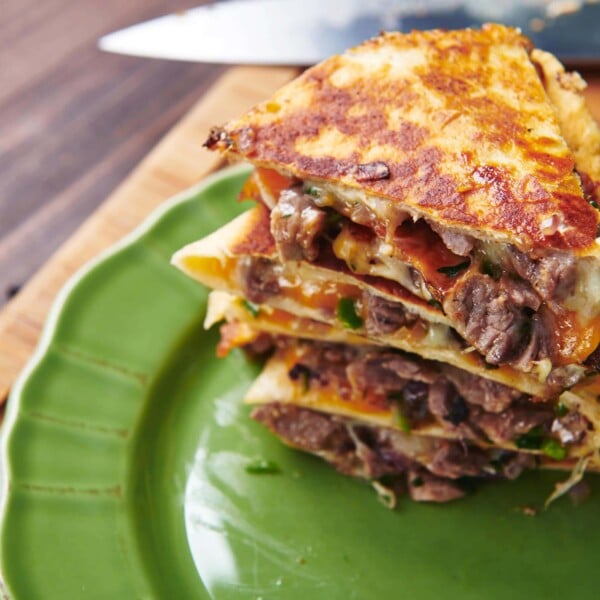Jewish Brisket for the Holidays
on Mar 27, 2020, Updated Jun 11, 2025
This post may contain affiliate links. Please read our disclosure policy.
Cooked low and slow in the oven, this is Jewish comfort food at its best. Perfect for Passover, Rosh Hashanah, Seder, and any chilly winter night.

This recipe is for Jewish-style brisket; the meat is braised low and slow in the oven until it becomes savory and fall-apart tender. The brisket, perfect for the Jewish holidays, is nestled in a combination of tomatoes, red wine, and broth (though you can use one or two of those liquids if you prefer). Down South, brisket is usually slow-cooked over indirect heat, with basting and smoking often involved.
This classic style of brisket is essentially a Jewish pot roast. I have made this brisket recipe about 50 times, for Rosh Hashanah, Passover, and just because, and it never fails to get raves. I season my brisket with some garlic and thyme, plus salt and pepper. Then the meat is gently braised in its sauce in a 300-degree oven with sweet chunks of carrots and lots of onions. It takes about 20 minutes to get into the oven, and then the cooking time is basically hands-off. Plus, you don’t have to sear the meat before baking it, which saves a step and some clean up.
By signing up, you agree to our Privacy Policy.
Serve this traditional Ashkenazi Jewish brisket recipe with mashed potatoes, roasted potatoes, or noodle kugel. Pick your side dishes accordingly if you want the meal to be Kosher or Kosher for Passover.
What's In This Post?

Many of us think of brisket during the Jewish holidays (Rosh Hashanah and Passover, in particular) and rarely otherwise. But like Jewish latkes, my family is so crazy about brisket that I make it for family dinners throughout the colder months. First, brisket is a pretty inexpensive cut of beef. Second, aside from acknowledging that it needs to cook for a few hours, it takes very little work. Don’t you just love a main course that you can ignore?
Make-Ahead Jewish Brisket
There are a few reasons to make the brisket a day or two ahead of time.
- It tastes better; the flavors really meld and blend with time, and the meat is at its most tender.
- Your life will be easier the next day because dinner is basically made.
- The fat will harden on the top of the sauce as it chills in the refrigerator. You can then scrape off the hardened layer of fat from the cooking liquid, creating a more concentrated sauce with no greasiness.
- It’s much easier to slice the brisket when it’s cold. Then you tuck the slices back into the sauce and reheat it at your leisure.

Leftover Brisket
Leftovers are fabulous and easy to reheat in the oven or on the stove over low heat. Leftover brisket will keep in an airtight container for up to 6 days.
You can also freeze brisket in a freezer-proof container or a freezer-proof zipper-top bag, with as little excess air as possible. I like to freeze brisket in some of its sauce. It will freeze for up to 6 months. Defrost in the refrigerator overnight.
I always make an extra-large brisket and plan for leftovers because my family loves this Brisket Barley Soup recipe almost as much as the original meal!
Best Sauce for Jewish Brisket
You’ll see that the brisket recipe calls for three liquids: broth, tomatoes, and wine, which result in a rich sauce with a nice depth of flavor. If you use only one or two of these liquids and just make the quantity equal to about 6 cups of braising liquid, the results will be fine. The tomato paste adds richness to the cooking liquid, but if you don’t have any, add some squirts of ketchup or skip it altogether.
Brisket tastes so good because of its long, slow cooking in liquid in the oven, and it’s fairly magnanimous about what kind of liquid it is braised in. Cooking the brisket in the sauce prevents the brisket from drying out.

Best Cut of Brisket for Baking in the Oven
First-cut brisket means brisket with much of the fat cut off. This is best if you are looking for a leaner sliced brisket. The second cut of brisket (also known as the point cut) has more fat and won’t dry out as easily. It’s really a matter of choice.
If you get a bigger piece of meat and want to cut it into two pieces, you can overlap them in the pot. Choose a brisket with nice fat marbling, which will result in the most moist, tender brisket.
What to Serve With Jewish Brisket
Pick and choose for a Rosh Hashanah, Hanukkah, or Passover Menu.
- I always pair this fork-tender brisket with a potato dish, like Herb Roasted Fingerling Potatoes.
- I always serve a salad with dinner — some favorites are Chopped Winter Salad, Romaine and Slivered Kale Salad with Lemon Dressing, and Mixed Lettuce Salad with Mustardy Dressing.
- Choose one or two simple vegetables to accompany this brisket, such as Roasted Asparagus, Sautéed Broccoli Rabe, or Roasted Lemon Brussels Sprouts.

Pin this now to find it later
Pin It
Jewish Brisket
Ingredients
- 1 teaspoon olive oil
- 2 teaspoons minced garlic
- 1 teaspoon dried thyme
- ¼ teaspoon freshly ground black pepper
- 1 first-cut beef brisket (4 to 5 pounds)
- 2 cups chopped onions
- 4 large carrots (peeled and thickly sliced)
- 3 bay leaves
- 3 tablespoons tomato paste (optional; see the Cooking Tip)
- 1 cup low-sodium beef or chicken broth
- 1 (28-ounce) can crushed tomatoes (in juice or puréed)
- 1 cup red wine (any kind is fine; or an additional cup crushed tomatoes or broth)
- 2 tablespoons finely chopped Italian flat-leaf parsley (optional; for garnish)
- 1 teaspoon kosher salt
Instructions
- Preheat the oven to 325 F.
- Place the olive oil, garlic, thyme, salt, and pepper in a small bowl and stir to mix. Rub the mixture all over.
- Place the brisket, fat side up, in a large casserole or Dutch oven with a tight-fitting lid. Toss in the onions, carrots, and bay leaves. If you are using the tomato paste, blend it into the broth, then pour over the meat and vegetables. Then, pour the crushed tomatoes and red wine, if using, on top. The liquid should cover the meat and most of the vegetables. Cover the casserole and bake the brisket until the meat is very tender, 3 to 3 1/2 hours.
- If you are serving the brisket the next day, let it cool, then put the entire casserole in the refrigerator. About an hour before serving, skim off any hardened fat, then take out the meat and cut off any excess fat from the top of the meat. Slice the brisket across the grain, as thin or thick as you like, then neatly return the sliced meat to the cooking liquid. Reheat the brisket on the stovetop over medium-low heat or in a preheated 325 F oven, until everything is warmed through and the cooking liquid has reduced and thickened up a bit, about 30 minutes in the oven, maybe less on the stovetop. Adjust seasonings as needed.
- If you are serving the brisket right away, remove the meat from the casserole and let it rest on a platter loosely tented with aluminum foil. Let the cooking liquid and vegetables sit for about 15 minutes, then spoon off any fat that has accumulated. Place the casserole over medium-high heat and simmer, stirring occasionally, until the liquid reduces a bit, about 10 minutes. Adjust seasonings as necessary. Slice the meat neatly across the grain, return it to the pot, and remove and discard the bay leaves.
- You can serve the brisket in the casserole or transfer it to a large shallow bowl. Remove and discard the bay leaves and sprinkle the parsley on top of the brisket, if desired.
Notes
Cooking Tips
- You’ll see that the brisket recipe calls for three liquids: broth, tomatoes, and wine. If you use only one or two of these and just make the quantity equal to about 6 cups of liquid, the results will be fine.
- The tomato paste adds richness to the cooking liquid and is great, but if you don’t have any, add some squirts of ketchup or skip it altogether.
- The reason brisket tastes so good is mostly because of its long, slow cooking in liquid, and it’s fairly magnanimous about what kind of liquid it is braised in.
- Leftover brisket? Use it to make Brisket Barley Soup.
Nutrition
More Jewish Holiday Main Course Options
- Chicken Marbella
- Chicken Thighs with Onions and Green Olives
- Garlicky Roast Chicken with Shallots and Potatoes
- Beef Brisket with Wild Mushrooms (another Jewish-style brisket!)













I love this recipe and was thinking of using an enameled cast iron casserole as it appears to be in one in the recipe photos- but I have never put my enameled cast iron in the fridge before. Anyone know if it’s safe to put it in the fridge overnight?
yes, it’s fine! I’m so glad you love the recipe (it’s in my own oven as I write this!)
I LOVE your cookbook! I’ve given 7 away as gifts!! I am so excited to be trying to make brisket for the first time this week. I’m from the south so the only brisket I’ve had is at BBQ joins where it’s served with coleslaw, baked beans, and potato salad. What sides would be appropriate with this dish?
that is so great to hear! It’s really anything you would think of with a pot roast or anther roast….roasted vegetables, andy kind of starch (mashed potatoes or roasted potatoes especially good), maybe steamed or roasted asparagus. Sauteed or roasted carrots or butternut squash. You’ll want to add color to the place, with the brown meat and the pale starch. And I always make salad with everything. let me know how it goes!
Hello, I found this recipe in your cookbook, and I was curious if you think the brisket could be cooked in a slow cooker, as opposed to in the oven?
I’m quite sure that would work perfectly well!
do you worry about the fat in this ?
that’s why I like to make it ahead; it’s easier to remove the fat once it rises to the top and hardens in the fridge.
I love brisket and will have to try your recipe. After reading your book, I also want to try the Beef Barley Soup, in addition to my other favorites with leftover brisket.
Loved the brisket and loved the beef barley soup. Both are definitely going in my rotation of meals.
Family favorites, both!